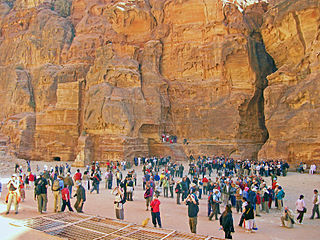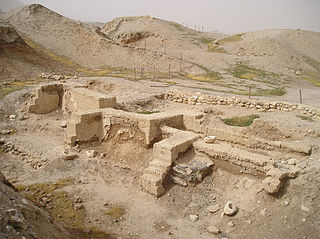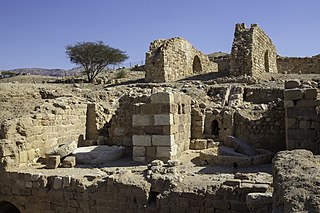Related Research Articles

Petra, originally known to its inhabitants as Raqmu or Raqēmō, is a historic and archaeological city in southern Jordan. It is adjacent to the mountain of Jabal Al-Madbah, in a basin surrounded by mountains forming the eastern flank of the Arabah valley running from the Dead Sea to the Gulf of Aqaba. The area around Petra has been inhabited from as early as 7000 BC, and the Nabataeans might have settled in what would become the capital city of their kingdom as early as the 4th century BC. Archaeological work has only discovered evidence of Nabataean presence dating back to the second century BC, by which time Petra had become their capital. The Nabataeans were nomadic Arabs who invested in Petra's proximity to the incense trade routes by establishing it as a major regional trading hub.

The Rockefeller Archeological Museum, formerly the Palestine Archaeological Museum, is an archaeology museum located in East Jerusalem that houses a large collection of artifacts unearthed in the excavations conducted in the region of Palestine, mainly in the 1920s and 1930s.
The year 1968 in archaeology involved some significant events.
GIS or Geographic Information Systems has been an important tool in archaeology since the early 1990s. Indeed, archaeologists were early adopters, users, and developers of GIS and GIScience, Geographic Information Science. The combination of GIS and archaeology has been considered a perfect match, since archaeology often involves the study of the spatial dimension of human behavior over time, and all archaeology carries a spatial component.

Hisham's Palace, also known as Khirbat al-Mafjar, is an important early Islamic archaeological site in the Palestinian city of Jericho, in the West Bank. Built by the Umayyad dynasty in the first half of the 8th century, it is one of the so-called Umayyad desert castles. It is located 3 km north of Jericho's city center, in an area governed by the Palestinian National Authority (PNA).

Jordan is a sovereign Arab state in the Middle East. The capital, Amman, is Jordan's most populous city as well as the country's economic, political and cultural centre.
The Umayyad desert castles, of which the desert castles of Jordan represent a prominent part, are fortified palaces or castles in what was the then Umayyad province of Bilad al-Sham. Most Umayyad "desert castles" are scattered over the semi-arid regions of north-eastern Jordan, with several more in Syria, Israel and the West Bank (Palestine).

Levantine archaeology is the archaeological study of the Levant. It is also known as Syro-Palestinian archaeology or Palestinian archaeology. Besides its importance to the discipline of Biblical archaeology, the Levant is highly important when forming an understanding of the history of the earliest peoples of the Stone Age.

Gerald Lankester Harding was a British archaeologist who was the director of the Department of Antiquities of Jordan from 1936 to 1956. His tenure spanned the period in which the Dead Sea Scrolls were discovered and brought to public awareness. Without his efforts many of the scrolls might have disappeared into private collections never to be seen again.
The Middle Eastern Geodatabase for Antiquities (MEGA) is a web based geographic information system or GIS developed by the Getty Conservation Institute (GCI), with matching funds from the World Monuments Fund (WMF) and in partnership with the Jordanian Department of Antiquities (DoA). The GIS will serve as the primary tool for the Jordanian DoA in its ongoing work to inventory, monitor, and manage Jordan's vast number of archaeological sites.

The Ministry of Tourism & Antiquities is the Egyptian government organization which serves to protect and preserve the heritage and ancient history of Egypt. In December 2019 it was merged into the Ministry of Tourism with Khaled al-Anani retaining his function.
The Comité de Conservation des Monuments de l'Art Arabe was an organization established in December 1881 by Khedive Tawfiq which was responsible for the preservation of Islamic and Coptic monuments in Egypt. It was an Egyptian institution, part of the Ministry of Charitable Endowments, but is often referred to by its French title.
Abdul-Karim Mahmud Gharaybeh was a Jordanian historian, academic and politician.

The Department of Antiquities is a government department of the Republic of Cyprus with responsibility for archaeological research and cultural heritage management. It was established in 1935 by the British colonial government. The department is headed by the Director of the Department of Antiquities, next in line is the position of the Director of the Cyprus Museum and following that, the Curator of Monuments. It has conducted excavations at Khoirokoitia, Kition, Amathus, Kourion, Paphos, Salamis, Enkomi and carried multiple rescue excavations all around the island. The Department publishes yearly the Report of the Department of Antiquities Cyprus (RDAC) and the Annual Report of the Department of Antiquities Cyprus (ARDAC).

Dimitri Constantine Baramki, often styled D. C. Baramki, was a Palestinian archaeologist who served as chief archaeologist at the Department of Antiquities of the Government of Mandatory Palestine from 1938 to 1948. From 1952 until his retirement, he was the curator of the Archaeological Museum at the American University of Beirut, Lebanon, where he served as a professor of archaeology.

Ghor es-Safi is an area in the Jordan valley, located in the Wadi al-Hasa. It is situated between the governorates of Karak and Tafilah, near the southern Dead Sea. The location is depicted on the 6th-century Madaba map as "Zoara."
Tall Damiyah is an Iron-Age archaeological site in Jordan. It is located in the Central Jordan Valley in the Balqa Governorate and is identified by most scholars with the historical and biblical city of Adama.
The archaeology of Ancient Egypt is the study of the archaeology of Egypt, stretching from prehistory through three millennia of documented history. Egyptian archaeology is one of the branches of Egyptology.
Hasan ʿAwad al-Qatshan was a Bedouin archaeologist associated with the Jordanian Department of Antiquities. Working with his partner Gerald Lankester Harding and other western archaeologists, he played a role in a number of major discoveries, including those of the Lachish letters and the Dead Sea Scrolls.
Izzat Dajani is a Jordanian banker and executive officer. He served as the chairman and CEO of Citibank in Qatar and is one of the founding members of the Royal Pharmaceutical Society of GB. He also is the co-founder and CEO of IMCapital Partners, and executive vice chairman of Capital Compass.
References
- ↑ "Department of Antiquities of Jordan & Petra Development and Tourism Regional Authority". UNESCO . Retrieved 2017-02-10.
- ↑ "Organizational structure". Ministry of Tourism and Antiquities. Retrieved 2017-02-10.
- ↑ "DoA Historical Background". Department of Antiquities. Archived from the original on 2017-02-11. Retrieved 2017-02-10.
- ↑ "Annual of the Department of Antiquities of Jordan". Department of Antiquities. Retrieved 2017-02-10.
- ↑ "The International Conference on the History And Archaeology of Jordan". Department of Antiquities. Retrieved 2017-02-10.
- ↑ "Middle Eastern Geodatabase for Antiquities (MEGA) - Jordan (2007–2014)". The Getty Conservation Institute. Retrieved 2017-02-10.
- 1 2 3 4 5 6 7 8 9 10 11 12 13 14 15 16 17 18 19 "DoA Historical Background". Department of Antiquities. Archived from the original on 2017-02-11. Retrieved 2017-02-10.